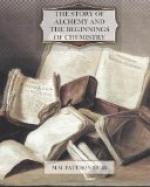CHAPTER X.
SUMMARY OF THE ALCHEMICAL DOCTRINE.—THE REPLACEMENT OF THE THREE PRINCIPLES OF THE ALCHEMISTS BY THE SINGLE PRINCIPLE OF PHLOGISTON.
The Sacred Art, which had its origin and home in Egypt, was very definitely associated with the religious rites, and the theological teaching, recognised by the state. The Egyptian priests were initiated into the mysteries of the divine art: and as the initiated claimed to imitate the work of the deity, the priest was regarded by the ordinary people as something more than a representative, as a mirror, of the divinity. The sacred art of Egypt was transmuted into alchemy by contact with European thought and handicrafts, and the tenets and mysticism of the Catholic Church; and the conception of nature, which was the result of this blending, prevailed from about the 9th until towards the end of the 18th century.
Like its predecessor, alchemy postulated an orderly universe; but alchemy was richer in fantastic details, more picturesquely embroidered, more prodigal of strange fancies, than the sacred art of Egypt.
The alchemist constructed his ordered scheme of nature on the basis of the supposed universality of life. For him, everything lived, and the life of things was threefold. The alchemist thought he recognised the manifestation of life in the form, or body, of a thing, in its soul, and in its spirit. Things might differ much in appearance, in size, taste, smell, and other outward properties, and yet be intimately related, because, according to the alchemist, they were produced from the same principles, they were animated by the same soul. Things might resemble one another closely in their outward properties and yet differ widely in essential features, because, according to the alchemist, they were formed from different elements, in their spiritual properties they were unlike. The alchemists taught that the true transformation, in alchemical language the transmutation, of one thing into another could be effected only by spiritual means acting on the spirit of the thing, because the transmutation consisted essentially in raising the substance to the highest perfection whereof it was capable; the result of this spiritual action might become apparent in the material form of the substance. In attempting to apply such vague conceptions as these, alchemy was obliged to use the language which had been developed for the expression of human emotions and desires, not only for the explanation of the facts it observed, but also for the bare recital of these facts.
The outlook of alchemy on the world outside human beings was essentially anthropomorphic. In the image of man, the alchemist created his universe.




